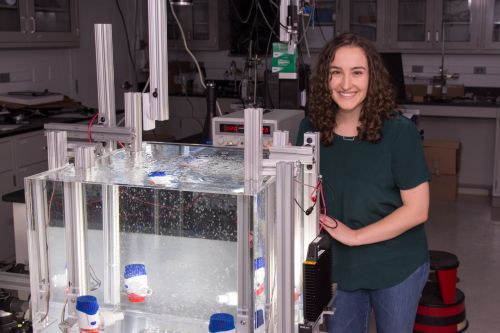
Megan Mazzatenta is an experimentalist studying ocean-atmosphere interaction through bubble bursting. What does that mean, exactly? Well, when a wave breaks at sea, it forms bubbles under the surface of the ocean. Those bubbles rise through a turbulent flow to the surface of the ocean, where they collect before ejecting droplets, called sea spray aerosols, into the atmosphere.
Megan explains, “The ejected droplets can act as cloud condensation nuclei once they enter the atmosphere, and they can also be carried over potentially large distances in the atmospheric boundary layer.” By knowing the sizes, compositions, and velocities they can work toward a “mechanistic model of sea spray production” to inform the development of better climate models. She says that salt and other chemical particulates can have a big effect on the radiative balance in the atmosphere after they are ejected too.
This past summer she spent a month immersed in her dream project at the Air-Sea Interaction Laboratory (ASI) at the University of Delaware focusing on wave breaking, bubble entrainment, surface bubble behavior, and droplet ejection. There are plenty of reasons to study bubbles and wave breaking and most of them involve environmental impacts.
Fortunately, Megan, a second-year PhD student, kept great company at ASI by working with a strong team led by two post doctorates: Baptiste Néel, and Martin Erinin, and fifth-year graduate student, Daniel Ruth. The setup at the ASI Lab allowed for large wind-wave tank measurements and the opportunity for experiments to further study the effects of those variables. “The trip was an incredible start to my research, and I felt like I was learning from the best,” Megan continues, “and I came out of it with even more excitement and confidence about our work and about my future as an experimentalist.”
When back at Princeton University, she began processing the collected data while also using this experience in her own experiments which are meant to be smaller versions of more realistic and complicated situations found in the ocean after a wave breaks—similar to the ASI Lab experiments.
Armed with her smaller tank than in Delaware, and based on a setup designed by Baptiste Néel, Megan says she “sends bubbles from the bottom of the tank from very small needles and creates a turbulent flow in the body of the water by shooting jets of water towards the center of the tank from different angles.” Her results are similar to the summer project even though she is on a smaller tank. Her focus in the future can be on adding chemical surfactants, or rather contaminating the water, and monitoring collective behavior of the bubbles.
Aside from the potential for better weather prediction, which is an amazing concept, the health aspects are what really motivate Megan in this field. The dependence between the production of ocean spray aerosol and meteorological and environmental variables is imperative for modeling potentially “health-adverse effects from dispersants used to break down oil spills, as well as quantify the production of cloud condensation nuclei originating from sea spray, which will affect radiative processes and cloud microphysical properties,” says her advisor, Assistant Professor, Luc Deike.
Deike explains that Megan works on experiments that “investigate the coupling between the chemical properties of contaminated water and the physical mechanism of droplet production when bubble bursts and how it controls aerosols production efficiency.”
Megan’s favorite aspect about her undergraduate research at the University of Virginia was the environmental application. When it came time to apply to graduate schools, she looked for labs where she could study environmental problems through fundamental fluid mechanics. She says she is riveted “by the idea that we can study problems like bubble bursting on a small scale and use that information to understand large, complex environmental processes, which could help improve climate models.”
As an NSF GRFP (Graduate Research Fellowship Program) recipient, Megan felt the fellowship application process helped her become more comfortable with the research topic and on broader impacts in the community. She explains that, “reaching women and other younger students interested in engineering is very important to me.” She hopes to become more involved in Graduate Women in Science and Engineering (GWISE) and the outreach program as a goal for the remainder of this year and next year.
Megan is a second-year representative on the MAE Graduate Student Committee where she helps plan orientation and visit days, answers questions from first year students, as well as helping with other events. It is just one way to give back.
She credits several people in her life as personal and academic influences. Megan says, “My biggest inspirations for everything is my family. My parents and my brother, Adam, are my support and the main reasons that I ended up in this great situation.”
Academically, she thinks back to her middle-school math teacher, Mrs. Sheatsley. “She helped me fall in love with math and was the first person to really teach me how to ask for and receive help when I didn’t understand the problems on my own. That lesson helped me get to this point in my career and it is such an undervalued skill.”
Her other major influence is Princeton alum Dan Quinn who is currently a professor at the University of Virginia. Megan says, “I would not be in graduate school or studying fluid mechanics if not for his teaching and mentorship. These amazing teachers and professors that guided my life are part of the reason I hope to be a professor one day.”
-- Verna Fisher